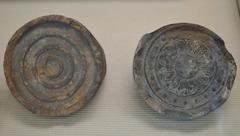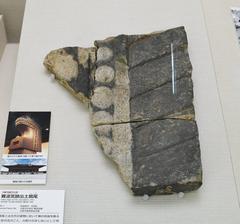
Naniwa Palace Visiting Hours, Tickets, and Historical Site Guide in Osaka
Date: 14/06/2025
Introduction: The Legacy of Naniwa Palace in Osaka
Naniwa Palace, located in present-day Osaka, stands as a profound symbol of Japan’s early imperial history. Established in 645 CE during the transformative Taika Reforms, Naniwa-no-miya was Japan’s first Chinese-style palace, marking the nation’s shift toward centralized governance and urban planning influenced by the Tang dynasty. Its position at the confluence of the Yamato and Yodo rivers—opening into Osaka Bay—cemented its significance as both a political capital and thriving commercial port, facilitating cultural and economic exchange with the Asian continent.
Though Naniwa’s time as imperial capital was brief, the site’s legacy endured as a vital cultural and commercial gateway. Today, visitors can explore Naniwa-no-miya Park, a nationally designated historic site preserving archaeological remains and reconstructed elements such as the Daigokuden (Great Hall of State). The adjacent Osaka Museum of History further enriches the experience through detailed exhibits, dioramas, and interactive displays, while innovations like augmented reality (AR) applications bring the palace’s ancient grandeur to life against the modern cityscape.
This comprehensive guide provides a deep dive into Naniwa Palace’s historical context, architectural features, and enduring legacy, along with practical advice on visiting hours, ticketing, accessibility, and surrounding attractions. Whether a history enthusiast or a casual traveler, this article will help you make the most of your journey into one of Osaka’s most treasured historical sites. For the latest visitor details, see the official resources: (Nippon.com), (Osaka Museum of History), (Japan Wonder Travel).
Table of Contents
- Historical Background
- Visiting Information
- Frequently Asked Questions (FAQ)
- Visuals and Media
- Conclusion and Final Tips
- References
Historical Background
Early Foundations and the Rise of Naniwa-no-miya
Naniwa—ancient Osaka—became Japan’s first Chinese-style imperial capital in 645 CE. Its strategic location at the confluence of the Yamato and Yodo rivers, forming the Naniwazu delta, created a natural hub for trade, politics, and culture (Nippon.com). The palace complex, completed by 652 CE, was a product of the Taika Reforms that introduced centralized authority and a grid-patterned city layout. Twelve vermilion-lacquered gateways became an architectural hallmark, influencing later Japanese shrines (Walking Across Japan).
Role as Imperial Capital and Subsequent Decline
Naniwa’s years as an imperial capital lasted until 694 CE, after which the court moved to Nara. However, Naniwa’s location ensured its continued role as a crucial port and commercial hub (Walking Across Japan). The palace was rebuilt several times, with a notable reconstruction in 744 CE under Emperor Shōmu (Nippon.com), but it never reclaimed its capital status after the move to Nara.
Archaeological Rediscovery and Modern Research
For centuries, the palace’s exact site was lost. In 1961, Professor Yamane Tokutarō led excavations that uncovered the Daigokuden’s foundations at Hōenzaka (Nippon.com). Subsequent decades of research yielded roof tiles, earthenware, and wooden documents, deepening knowledge of early Japanese statecraft (Osaka Museum of History). These artifacts are now displayed in the Osaka Museum of History.
Architectural Features and Urban Design
Naniwa Palace was remarkable for its scale and Chinese-inspired symmetry. The Daigokuden featured massive pillars and a decorated ceiling, while the compound’s gates and axial layout reflected Tang dynasty influence (Nippon.com). Museum dioramas and reconstructions recreate the palace’s 8th-century splendor.
Naniwa’s Transformation and Enduring Legacy
After its political era, Naniwa became an economic powerhouse. In the medieval period, it was a vital trading hub, and during the Edo period, Osaka became the “kitchen of the nation” (Nippon.com). The city’s evolution from imperial capital to commercial center is chronicled at the Osaka Museum of History (Japan Guide).
Visiting Information
Visiting Hours and Tickets
- Naniwa-no-miya Park: Open daily, generally from 6:00 AM to 9:00 PM. Admission is free.
- Osaka Museum of History: Open 9:30 AM–5:00 PM (last admission 4:30 PM), closed Tuesdays and during New Year’s holidays. Adult tickets are ~600 yen, with student and senior discounts (Osaka Museum of History).
Accessibility and Travel Tips
- Access: Closest stations are Tanimachi 4-chome and Morinomiya (Osaka Metro).
- Barrier-free: Both park and museum are wheelchair accessible with ramps and elevators.
- Best times to visit: Weekdays, spring (cherry blossoms) and autumn (foliage). Bring a camera for the vibrant gates and dioramas.
- Navigation: Entering via the Osaka Museum of History or following digital map apps is recommended (Inside Osaka).
Guided Tours and Special Events
The Osaka Museum of History provides guided tours focusing on Naniwa-no-miya’s history and archaeological finds. Seasonal festivals, reenactments, and workshops are held in the park and museum. Some tours offer multilingual audio guides (japan-travel-note.com).
Nearby Attractions
- Osaka Castle: Panoramic city views and historical exhibits, ~10–15 minutes’ walk.
- Shitenno-ji Temple: Japan’s oldest state-sponsored Buddhist temple, nearby.
- Dotonbori & Shinsaibashi: Lively districts for dining and shopping.
- Patina Osaka Hotel: Overlooking the park, opening in 2025 with luxury amenities (Japan Wonder Travel).
Frequently Asked Questions (FAQ)
Q: What are the visiting hours for Naniwa-no-miya Park and Osaka Museum of History?
A: The park is open daily, generally from 6:00 AM to 9:00 PM. The museum is open 9:30 AM–5:00 PM, closed Tuesdays.
Q: Do I need tickets to visit Naniwa-no-miya Park?
A: No, the park is free. The museum charges admission (~600 yen for adults).
Q: Is the site accessible for people with disabilities?
A: Yes, both the park and museum are wheelchair accessible.
Q: Are guided tours available?
A: Yes, the museum offers guided tours and multilingual audio guides.
Q: When is the best time to visit?
A: Spring (cherry blossoms) and autumn (fall foliage) offer the best scenery and weather.
Visuals and Media
Explore the site with high-quality images and virtual tours via the Osaka Museum of History’s website. AR experiences are available using the free “Styly” app, allowing digital reconstructions of the palace overlaying the ruins (Yomiuri Shimbun). Image alt tags such as “Naniwa-no-miya vermilion gates,” “Daigokuden palace ruins Osaka,” and “Osaka historical sites Naniwa-no-miya” enhance accessibility and SEO.
Conclusion and Final Tips
Naniwa Palace encapsulates Japan’s early advances in governance, urban planning, and cultural exchange. Its rediscovery and preservation have transformed the site into a dynamic blend of heritage, education, and community engagement. Free entry to the park, affordable museum tickets, and innovative AR tools make Naniwa Palace accessible to all. Combine your visit with nearby attractions for a full day of Osaka history.
Travel Tips:
- Download the “Styly” AR app before your visit.
- Check the Osaka Museum of History for event updates and ticketing.
- Visit in spring or autumn for the best experience.
- Use official resources and the Audiala app for real-time information.
For a deeper understanding of Japan’s ancient capitals, Naniwa Palace is an essential destination—offering both serene park settings and immersive history.
References
- Nippon.com Guide to Naniwa-no-miya
- Osaka Museum of History
- Japan Wonder Travel – New Openings and Renewals in Osaka
- Inside Osaka – Naniwa Palace Ruins
- Yomiuri Shimbun Feature
- Japan Guide – Osaka Castle
- osaka.com – Osaka Museum of History
- japan-travel-note.com – Naniwa-no-miya
- Osaka Info – Naniwa-no-miya Palace
- Trip.com – Naniwa-no-miya Ato Park
- Kanpai Japan – Osaka Museum of History
- Japan Insides – Osaka Museum of History
- Magical Trip – Events in Osaka
- Japan Highlights – Osaka Weather
- Wikipedia – Naniwa Nagara-Toyosaki Palace








































































